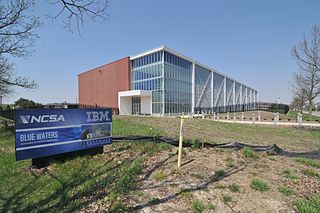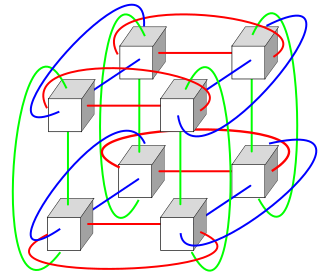
SPARC is a reduced instruction set computing (RISC) instruction set architecture (ISA) originally developed by Sun Microsystems. Its design was strongly influenced by the experimental Berkeley RISC system developed in the early 1980s. First released in 1987, SPARC was one of the most successful early commercial RISC systems, and its success led to the introduction of similar RISC designs from a number of vendors through the 1980s and 90s.

Blue Gene is an IBM project aimed at designing supercomputers that can reach operating speeds in the PFLOPS (petaFLOPS) range, with low power consumption.

Blue Waters is a petascale supercomputer at the National Center for Supercomputing Applications (NCSA) at the University of Illinois at Urbana-Champaign. On August 8, 2007, the National Science Board approved a resolution which authorized the National Science Foundation to fund "the acquisition and deployment of the world's most powerful leadership-class supercomputer." The NSF awarded $208 million for the Blue Waters project.
In computing, performance per watt is a measure of the energy efficiency of a particular computer architecture or computer hardware. Literally, it measures the rate of computation that can be delivered by a computer for every watt of power consumed. This rate is typically measured by performance on the LINPACK benchmark when trying to compare between computing systems.
SiCortex was a supercomputer manufacturer founded in 2003 and headquartered in Clock Tower Place, Maynard, Massachusetts. On 27 May 2009, HPCwire reported that the company had shut down its operations, laid off most of its staff, and is seeking a buyer for its assets. The Register reported that Gerbsman Partners was hired to sell SiCortex's intellectual properties. While SiCortex had some sales, selling at least 75 prototype supercomputers to several large customers, the company had never produced an operating profit and ran out of venture capital. New funding could not be found.
The SPARC64 V (Zeus) is a SPARC V9 microprocessor designed by Fujitsu. The SPARC64 V was the basis for a series of successive processors designed for servers, and later, supercomputers.

Jaguar or OLCF-2 was a petascale supercomputer built by Cray at Oak Ridge National Laboratory (ORNL) in Oak Ridge, Tennessee. The massively parallel Jaguar had a peak performance of just over 1,750 teraFLOPS. It had 224,256 x86-based AMD Opteron processor cores, and operated with a version of Linux called the Cray Linux Environment. Jaguar was a Cray XT5 system, a development from the Cray XT4 supercomputer.
India's supercomputer program was started in late 1980s because Cray supercomputers were denied for import due to an arms embargo imposed on India, as it was a dual-use technology and could be used for developing s.

Japan operates a number of centers for supercomputing which hold world records in speed, with the K computer becoming the world's fastest in June 2011.
Tsubame is a series of supercomputers that operates at the GSIC Center at the Tokyo Institute of Technology in Japan, designed by Satoshi Matsuoka.

The history of supercomputing goes back to the early 1920s in the United States with the IBM tabulators at Columbia University and a series of computers at Control Data Corporation (CDC), designed by Seymour Cray to use innovative designs and parallelism to achieve superior computational peak performance. The CDC 6600, released in 1964, is generally considered the first supercomputer. However, some earlier computers were considered supercomputers for their day, such as the 1954 IBM NORC, the 1960 UNIVAC LARC, and the IBM 7030 Stretch and the Atlas, both in 1962.

Several centers for supercomputing exist across Europe, and distributed access to them is coordinated by European initiatives to facilitate high-performance computing. One such initiative, the HPC Europa project, fits within the Distributed European Infrastructure for Supercomputing Applications (DEISA), which was formed in 2002 as a consortium of eleven supercomputing centers from seven European countries. Operating within the CORDIS framework, HPC Europa aims to provide access to supercomputers across Europe.

Approaches to supercomputer architecture have taken dramatic turns since the earliest systems were introduced in the 1960s. Early supercomputer architectures pioneered by Seymour Cray relied on compact innovative designs and local parallelism to achieve superior computational peak performance. However, in time the demand for increased computational power ushered in the age of massively parallel systems.

XK7 is a supercomputing platform, produced by Cray, launched on October 29, 2012. XK7 is the second platform from Cray to use a combination of central processing units ("CPUs") and graphical processing units ("GPUs") for computing; the hybrid architecture requires a different approach to programming to that of CPU-only supercomputers. Laboratories that host XK7 machines host workshops to train researchers in the new programming languages needed for XK7 machines. The platform is used in Titan, the world's second fastest supercomputer in the November 2013 list as ranked by the TOP500 organization. Other customers include the Swiss National Supercomputing Centre which has a 272 node machine and Blue Waters has a machine that has Cray XE6 and XK7 nodes that performs at approximately 1 petaFLOPS (1015 floating-point operations per second).

Summit or OLCF-4 is a supercomputer developed by IBM for use at Oak Ridge National Laboratory, which as of November 2018 is the fastest supercomputer in the world, capable of 200 petaflops. Its current LINPACK benchmark is clocked at 143.5 petaflops. As of November 2018, the supercomputer is also the 3rd most energy efficient in the world with a measured power efficiency of 14.668 GFlops/watt. Summit is the first supercomputer to reach exaop speed, achieving 1.88 exaops during a genomic analysis and is expected to reach 3.3 exaops using mixed precision calculations.
The Sunway BlueLight (神威蓝光) is a Chinese massively parallel supercomputer. It is the first publicly announced PFLOPS supercomputer using Sunway processors solely developed by the People's Republic of China.
The HPCGbenchmark is a supercomputing benchmark test proposed by Michael Heroux from Sandia National Laboratories, and Jack Dongarra and Piotr Luszczek from the University of Tennessee. It is intended to model the data access patterns of real-world applications such as sparse matrix calculations, thus testing the effect of limitations of the memory subsystem and internal interconnect of the supercomputer on its computing performance. Because it is internally I/O bound, HPCG testing generally achieves only a tiny fraction of the peak FLOPS of the computer.















